Ferns of the Adirondacks:
Sensitive Fern (Onoclea sensibilis L.)
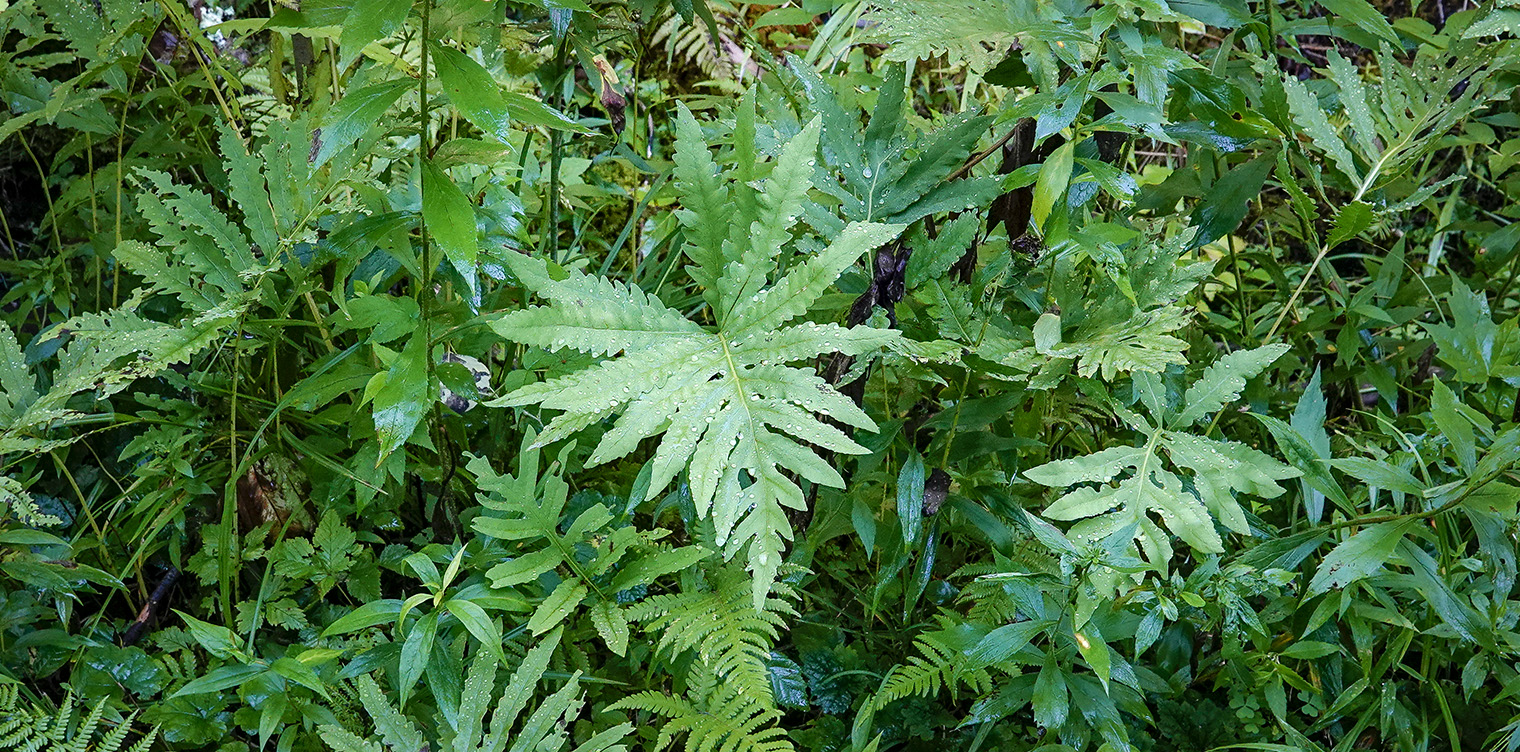
The Sensitive Fern (Onoclea sensibilis L.) is a native fern that grows primarily in wetlands and wet forests in the Adirondack Mountains of New York State. The Sensitive Fern is one of three ferns in New York State that are not protected. The other two are Hay-scented Fern and Eastern Bracken Fern.
The Sensitive Fern is a member of the Sensitive Fern Family (Onocleaceae), which also includes the Ostrich Fern (Matteuccia struthiopteris).
- The common name of the Sensitive Fern derives from the fact that this fern is very sensitive to cold weather; the sterile frondsSterile frond: A frond without sporangia (spore cases). brown and wither with the coming of winter. This fern is also called Bead Fern – a reference to the beaded pinnae
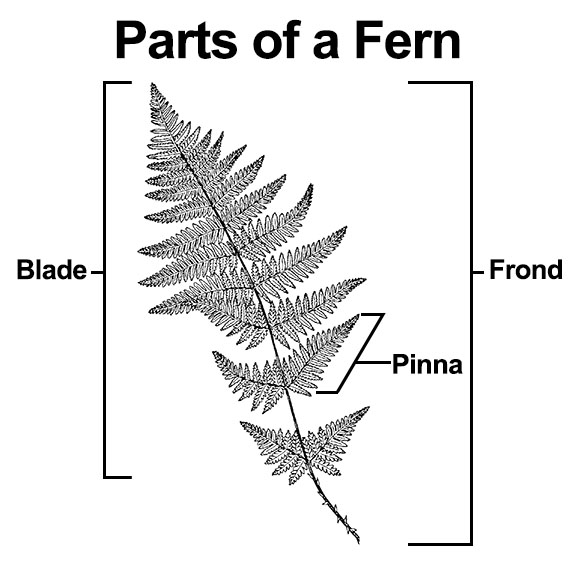 Pinna: A primary division of the blade (plural: pinnae). (leaflets) on its fertile frondsFertile frond: A frond with sporangia (spore cases)..
Pinna: A primary division of the blade (plural: pinnae). (leaflets) on its fertile frondsFertile frond: A frond with sporangia (spore cases).. - The genus name (onoclea) is from the Greek words onos (vessel) and kleiein (to close); this is a reference to the bead-like structures that enclose the soriSorus: A cluster of sporangia, usually borne on the underside or margins of the pinnae or pinnules. (plural = sori).
- The species name (sensibilis) is Latin for sensitive, which is another reference to the quick death of the sterile fronds following a frost.
Fossils of this fern dating back more than 60 million years look quite similar to Sensitive Ferns of today, suggesting that this fern has survived relatively unchanged since the Paleocene Epoch.
Identification of Sensitive Ferns
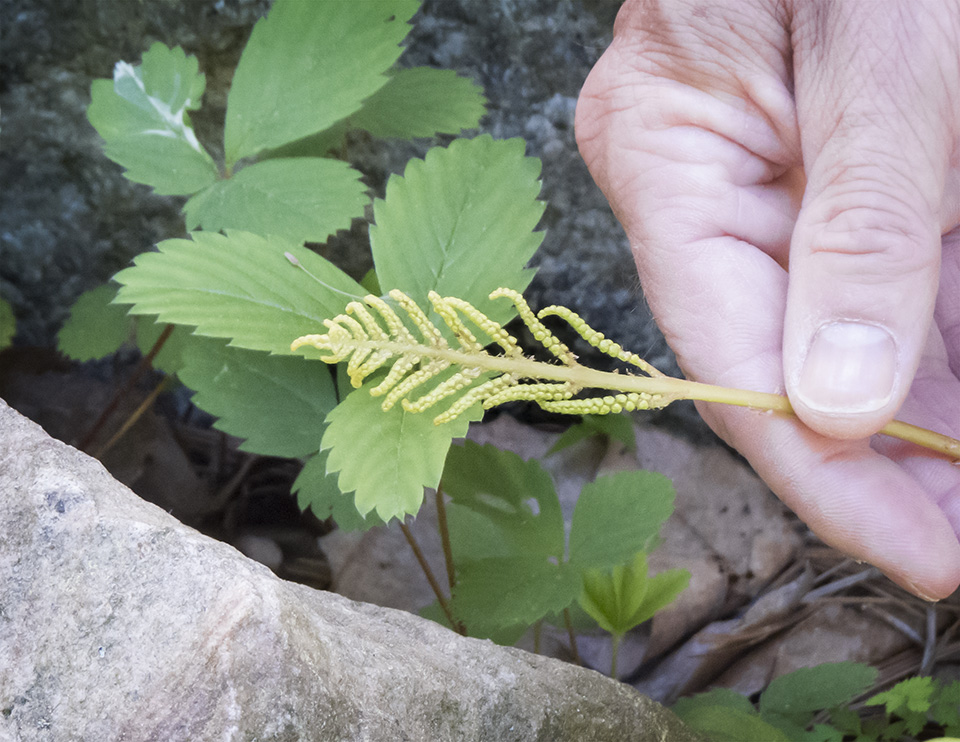
The Sensitive Fern has broad, almost triangular fronds, which contrast with the lacy appearance of many ferns. The fronds emerge individually from a spreading rhizome Rhizome: The modified subterranean stem of a plant that sends out roots and shoots from its nodes. Rhizomes are also called creeping rootstalks and rootstocks., sometimes forming colonies. The fiddleheadsFiddlehead: The unfurling young frond of true ferns, which loosely resembles the ornate, curled end of a fiddle. (Synonym=crosier) which emerge in the spring are a pale red.
Rhizome: The modified subterranean stem of a plant that sends out roots and shoots from its nodes. Rhizomes are also called creeping rootstalks and rootstocks., sometimes forming colonies. The fiddleheadsFiddlehead: The unfurling young frond of true ferns, which loosely resembles the ornate, curled end of a fiddle. (Synonym=crosier) which emerge in the spring are a pale red.
The fronds of the Sensitive Fern are dimorphicFrond dimorphism: Refers to a difference in ferns between the fertile and sterile fronds., which means that the sterile and fertile fronds are very different in appearance, providing an important clue to the fern's identification.
- The sterile frondsSterile frond: A frond without sporangia (spore cases). of Sensitive Fern are yellow-green to pale green, triangular, and up to 40 inches tall, with scattered white hairs on the undersurfaces. These fronds are cut into about a dozen nearly opposite pairs of pinnae, which have prominent netted veins and wavy edges. The sterile fronds turn brown and die back after the first frost.
- The fertile (spore-bearing) frondsFertile frond: A frond with sporangia (spore cases). are much shorter when mature, about ten to twenty inches long, and about an inch or so wide. The early growth is green, with numerous, steeply ascending, narrow pinnae. The sori (clusters of sporangiaSporangium: Spore cases inside which the spores develop. (plural = sporangia) – the capsules that bear the spores) are in beadlike divisions of the fertile pinnae. They are green at first, maturing to dark brown. The fertile fronds are not evergreen, but they persist through winter and release the green spores in the spring before the sterile fronds expand.
Sensitive Ferns are similar in appearance to the Netted Chain Fern (Lorinseria areolata). However, the leaf lobe margins of the latter fern are minutely toothed rather than wavy (as is the case with Sensitive Fern). In any event, Netted Chain Ferns do not grow in the Adirondack Park; in New York State, they are confined to the coastal regions.
Uses of Sensitive Ferns
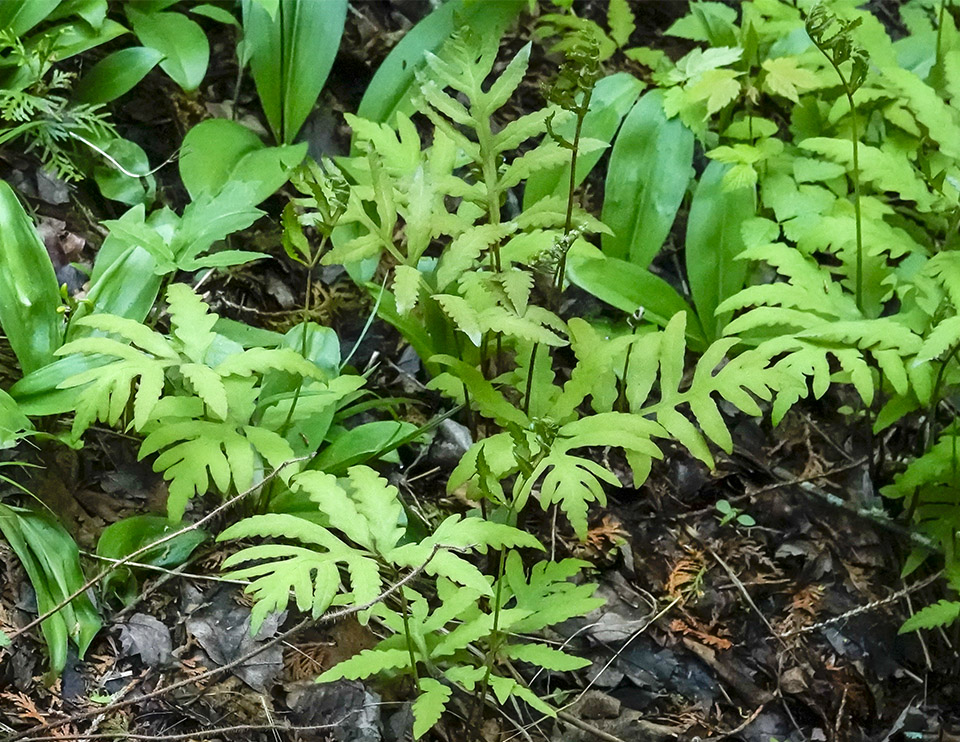
Sensitive Ferns have limited use as a food. The Iroquois are said to have eaten this fern as a vegetable cooked and seasoned with salt, pepper, or butter. Other reports indicate that the fiddleheads have been used as a vegetable, steamed in a little water, or eaten raw.
Some sources suggest that caution should be used with regard to this fern, among others, as some ferns reportedly contain carcinogens and/or thiaminase, an enzyme that robs the body of Vitamin B if taken in large quantities.
This fern does not seem to have been used extensively as a medicine. Some native American groups used the plant as a medication for blood problems, arthritis, and infection; others used it to treat various gynecological ailments.
Wildlife Value of Sensitive Ferns
Sensitive Ferns have limited wildlife value. Wild Turkeys reportedly feed on the fertile fronds of Sensitive Ferns in winter, when food is scarce. The Sensitive Fern is the host plant for the Sensitive Fern Borer (Papaipema inquaesita), which feeds on its stems and rhizomes. Several other insects also are known to feed on the leaves or plant juices. The plant also provides shelter to salamanders and frogs.
Distribution of Sensitive Ferns
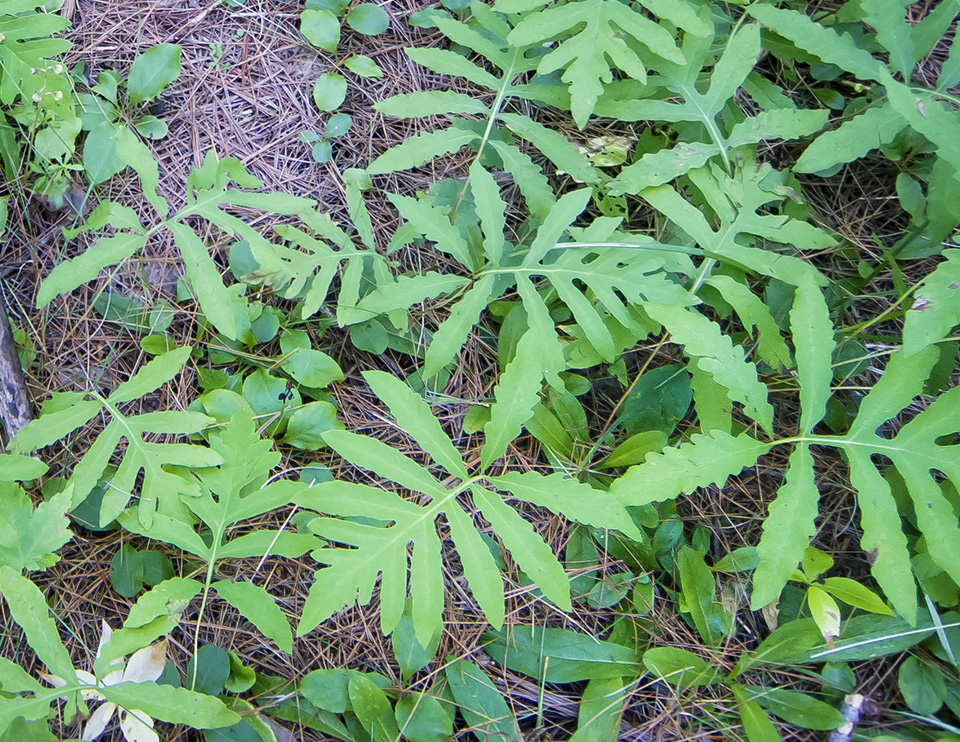
The range of the Sensitive Fern includes eastern North America. It is found mainly east of the Great Plains, as well as in the southern provinces of Canada.
This fern is present in all counties of New York State, except Wyoming County in western New York. Sensitive Ferns have been documented in all counties within the Adirondack Park Blue Line.
Habitat of Sensitive Ferns
Sensitive Ferns are moderately shade-tolerant; they seem to do well in full sun, but will also grow in shade, in neutral to acid soil. Sensitive Ferns prefer poorly drained areas, including swamps, marshes, wet fields, stream banks, moist woods, and sites bordering boggy areas.
Sensitive Ferns can sometimes be found in northern hardwood forests, but in this habitat they are rare to infrequent. These plants apparently prefer sites that have not been disturbed by logging. At the Forest Ecosystem Research and Demonstration Area (FERDA) plots at the Paul Smiths VIC, Sensitive Ferns decreased in frequency in the decade after single-tree selection and shelterwood cuts.
In the Adirondack Mountains, Sensitive Ferns are most commonly found in wetland ecological communities, including:
For instance, the Northern White Cedar Swamp ecological community is a conifer or mixed woods swamp commonly seen along the shores of lakes and streams in northern New York.
- The dominant tree is the Northern White Cedar, often mixed with other conifers and hardwoods, such as Red Maple, Eastern Hemlock, Yellow Birch, Balsam Fir, and Tamarack.
- The shrub layer is usually sparse, and might include Specked Alder and Highbush Blueberry.
- The ground layer is more diverse. Look for Goldthread, Starflower, Bunchberry, Canada Mayflower, Clintonia, Creeping Snowberry, and Partridgeberry growing near Sensitive Ferns and other ferns such as Cinnamon Fern and Royal Fern.
- Mosses typical of this ecological community include Stair-step Moss and Sphagnum.
- Characteristic birds to look and listen for in this community include Winter Wrens, White-throated Sparrows, and Golden-crowned Kinglets.
Sensitive Ferns can be seen on many of the trails covered here, including the Peninsula Nature Trails, the Barnum Brook Trail at the Paul Smith's College VIC, the Sucker Brook Trail at the Adirondack Interpretive Center, in the wetland area on Hulls Falls Road, and on the Heart Lake Trail, where it can be seen in the Nature Museum's Fern Garden, as well as on the Ski Slope.
List of Adirondack Ferns
References
Michael Kudish. Adirondack Upland Flora: An Ecological Perspective (Saranac, New York: The Chauncy Press, 1992), p. 86.
Boughton Cobb. A Field Guide to Ferns and their Related Families. Northeastern and Central North America. Second Edition (Houghton Mifflin Company, 2005), pp. 166-169.
New York Flora Association. New York Flora Atlas. Onoclea sensibilis L. Retrieved 21 February 2017.
United States Department of Agriculture. The Plants Database. Onoclea sensibilis L. Sensitive Fern. Retrieved 21 February 2017.
Flora of North America. Onoclea sensibilis Linnaeus. Retrieved 21 February 2017.
Michael Burgess. A Field Guide to the Ferns of New England and Adjacent New York. Retrieved 16 February 107, pp. 94-95.
Richard Mitchell. Atlas of New York State Ferns (New York State Museum, 1984), p. 21. Retrieved 15 February 2017.
Eugene C. Ogden. Field Guide to Northeastern Ferns (New York State Museum, 1981), pp. 85-86. Retrieved 15 February 2017.
William J. Cody and Donald M. Britton. Ferns and Fern Allies of Canada (Research Branch. Agriculture Canada, 1989), pp. 168-170. Retrieved 19 February 2017.
David B. Lellinger. A Field Manual of the Ferns & Fern Allies of the United States and Canada (Smithsonian Institution Press, 1985), pp. 247-248, Plate 316.
Steve W. Chadde. Northeast Ferns: A Field Guide to the Ferns and Fern Relatives of the Northeastern United States (CreateSpace Independent Publishing Platform, 2013), pp. 196, 200.
Anne C. Hallowell and Barbara G. Hallowell. Fern Finder. Second Edition (Nature Study Guild Publishers, 2001), p. 15.
Integrated Taxonomic Information System. Onoclea sensibilis L. Retrieved 5 January 2018.
New York State. Department of Environmental Conservation. New York Natural Heritage Program. Ecological Communities of New York State. Second Edition (March 2014), pp. 48-49, 55-56, 66, 69-70, 71-72, 74-75, 75-76. Retrieved 17 October 2015.
New York Natural Heritage Program. 2019. Online Conservation Guide for Floodplain Forest. Retrieved 7 July 2019.
New York Natural Heritage Program. 2019. Online Conservation Guide for Hemlock-Hardwood Swamp. Retrieved 7 July 2019.
New York Natural Heritage Program. 2019. Online Conservation Guide for Northern White Cedar Swamp. Retrieved 7 July 2019.
New York Natural Heritage Program. 2019. Online Conservation Guide for Rich Hemlock-Hardwood Peat Swamp. Retrieved 7 July 2019.
New York Natural Heritage Program. 2019. Online Conservation Guide for Sedge Meadow. Retrieved 7 July 2019.
New York Natural Heritage Program. 2019. Online Conservation Guide for Shallow Emergent Marsh. Retrieved 7 July 2019.
New York Natural Heritage Program. 2019. Online Conservation Guide for Silver Maple-Ash Swamp. Retrieved 7 July 2019.
New York State. Adirondack Park Agency. Preliminary List of Species Native Within the Adirondack Park Listed Alphabetically by Scientific Name and Sorted by Habit. Volume 1. Updated 10.23.2006, p. 58. Retrieved 26 January 2017.
Connecticut Botanical Society. Quick Guide to the Common Ferns of New England. Sensitive Fern (Bead Fern). Onoclea sensibilis L. Retrieved 21 February 2017.
Gary Wade et al. Vascular Plant Species of the Forest Ecology Research and Demonstration Area, Paul Smiths, New York. USDA Forest Service. Research Note NE-380, p. 5. Retrieved 22 January 2017.
Mark J. Twery, et al. Changes in Abundance of Vascular Plants under Varying Silvicultural Systems at the Forest Ecosystem Research and Demonstration Area, Paul Smiths, New York. USDA Forest Service. Research Note NRS-169, p. 9. Retrieved 22 January 2017.
Native Plant Trust. Go Botany. Sensitive Fern. Onoclea sensibilis L. Retrieved 7 July 2019.
University of Wisconsin. Flora of Wisconsin. Onoclea sensibilis L. Retrieved 5 January 2018.
Minnesota Wildflowers. Onoclea sensibilis. Sensitive Fern. Retrieved 5 January 2018.
Illinois Wildflowers. Sensitive Fern. Onoclea sensibilis. Retrieved 5 January 2018.
Eloise Butler Wildflower Garden. The Friends of the Wild Flower Garden. Sensitive Fern. Onoclea sensibilis L. Retrieved 5 January 2018.
Lady Bird Johnson Wildflower Center. Onoclea sensibilis. Retrieved 5 January 2018.
John Eastman. The Book of Swamp and Bog: Trees, Shrubs, and Wildflowers of Eastern Freshwater Wetlands (Stackpole Books, 1995), pp. 73-76.
John Eastman, "Wild Turkey," The Eastman Guide to Birds: Natural History Accounts for 150 North American Species. Kindle Edition. (Stackpole Books, 2012).
Ellen Rathbone, "Crazy About Ferns in the Adirondacks," Adirondack Almanack, 20 January 2010. Retrieved 17 February 2017.
University of Michigan. Native American Ethnobotany. A Database of Foods, Drugs, Dyes and Fibers of Native American Peoples, Derived from Plants. Onoclea sensibilis L. Sensitive Fern. Retrieved 21 February 2017.
Plants for a Future. Onoclea sensibilis - L. Retrieved 21 February 2017.
The Cornell Lab of Ornithology. Birds of North America. Wild Turkey. Subscription web site. Retrieved 6 January 2018.
Butterflies and Moths of North America. Papaipema inquaesita. Retrieved 21 February 2017.
Iowa State University. BugGuide. Papaipema inquaesita - Sensitive Fern Borer. Retrieved 21 February 2017.
Allen J. Coombes. Dictionary of Plant Names (Timber Press, 1994), p. 129.
Charles H. Peck. Plants of North Elba (Bulletin of the New York State Museum, Volume 6, Number 28, June 1899), p. 155. Retrieved 22 February 2017.
